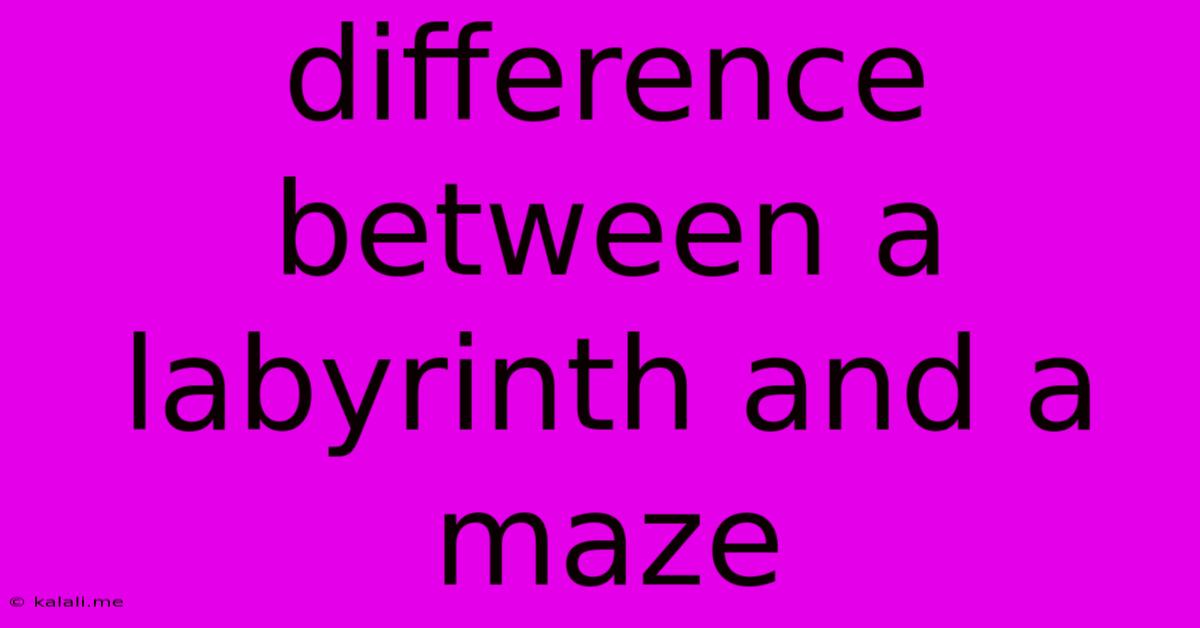Difference Between A Labyrinth And A Maze
Kalali
May 19, 2025 · 3 min read

Table of Contents
Labyrinth vs. Maze: Unraveling the Differences
While often used interchangeably, labyrinths and mazes are distinct puzzle structures with unique characteristics. Understanding these differences is crucial, whether you're designing a game, landscaping your garden, or simply satisfying your intellectual curiosity. This article delves into the key distinctions between these two captivating pathways, exploring their historical significance and practical applications. This guide will help you understand the core differences, making you an expert on the subject.
What is a Labyrinth?
A labyrinth is a single path, a continuous route leading to a central point. There are no dead ends, no choices to be made. The path may be winding and complex, designed to challenge your focus and patience, but the journey is predetermined. Think of the classic design – a circular or square pattern with a single, meandering path spiraling towards the center.
Key Characteristics of Labyrinths:
- Single path: Only one way to reach the center.
- No dead ends: The path is continuous, eliminating the possibility of getting lost.
- Meditative purpose: Often used for spiritual reflection and contemplation.
- Ancient history: Labyrinths date back to ancient civilizations, found in various cultures and contexts.
- Symbolic representation: Frequently symbolizes a journey towards self-discovery or a spiritual goal.
What is a Maze?
Unlike the labyrinth's singular path, a maze presents numerous pathways, choices, and potential dead ends. Navigating a maze requires decision-making and problem-solving skills, as you must choose your route carefully to reach the exit. Mazes can be simple or incredibly complex, often featuring intricate branching paths and confusing layouts.
Key Characteristics of Mazes:
- Multiple paths: Many routes, with the need for decision-making.
- Dead ends: Incorrect choices often lead to blind alleys.
- Problem-solving required: Finding the exit requires strategy and exploration.
- Recreational purpose: Primarily used for entertainment and amusement.
- Variety of designs: Mazes can have diverse shapes, sizes, and levels of complexity.
Comparing Labyrinths and Mazes: A Table Summary
| Feature | Labyrinth | Maze |
|---|---|---|
| Path | Single, continuous | Multiple, branching |
| Dead Ends | None | Many |
| Choices | None | Many |
| Purpose | Meditative, symbolic | Recreational, challenging |
| Problem-solving | Minimal | Required |
Beyond the Basics: Types and Examples
Both labyrinths and mazes exist in many forms. Classical labyrinths, like the one found in the Chartres Cathedral, are known for their elegant simplicity. Mazes, on the other hand, range from simple children's puzzles to incredibly complex hedge mazes found in gardens and theme parks. Computer games frequently incorporate both labyrinth and maze structures, offering players varied challenges. The choice of which to implement often depends on the desired game mechanics and player experience.
Conclusion:
Understanding the fundamental differences between labyrinths and mazes allows for a deeper appreciation of their unique qualities. Whether you're drawn to the meditative qualities of a labyrinth or the problem-solving aspect of a maze, both offer enriching experiences. Their enduring presence in art, architecture, and games speaks to their universal appeal and ability to challenge and inspire.
Latest Posts
Latest Posts
-
I Would Appreciate If You Could
May 19, 2025
-
Did Top Gear Really Discover The Source Of The Nile
May 19, 2025
-
How Much Caffeine In A Teaspoon Of Coffee
May 19, 2025
-
How To Prepare Cockles For Cooking
May 19, 2025
-
How Many Cards Are In A Deck Pokemon
May 19, 2025
Related Post
Thank you for visiting our website which covers about Difference Between A Labyrinth And A Maze . We hope the information provided has been useful to you. Feel free to contact us if you have any questions or need further assistance. See you next time and don't miss to bookmark.